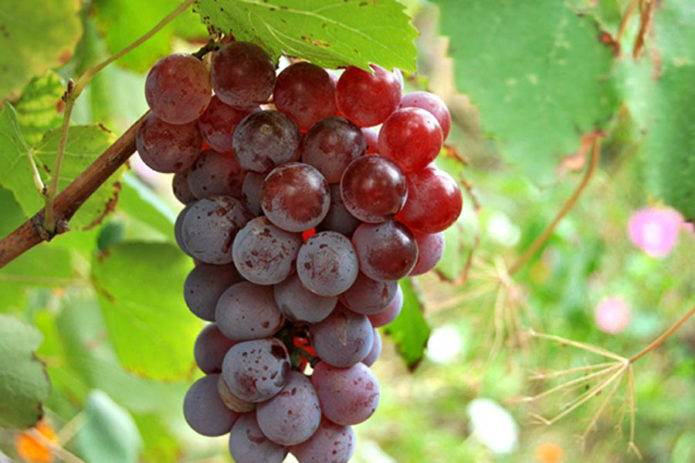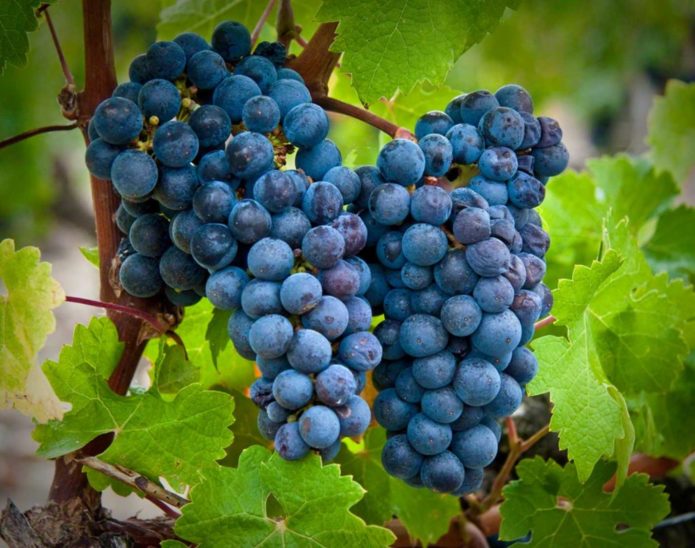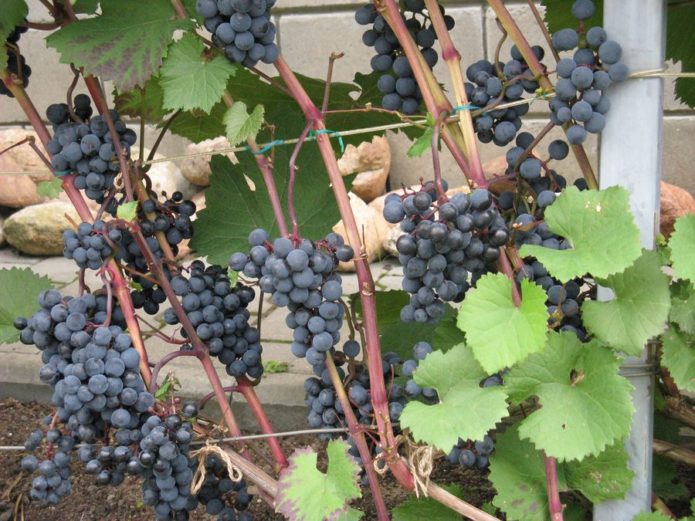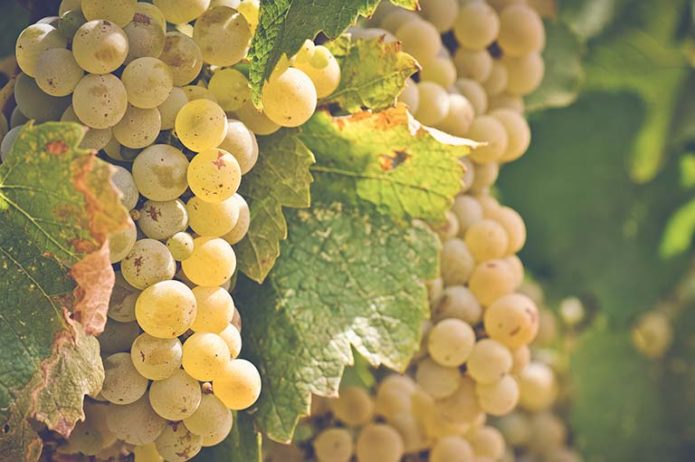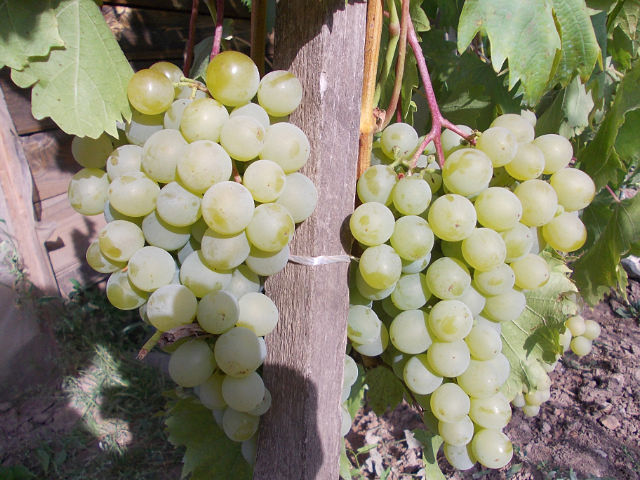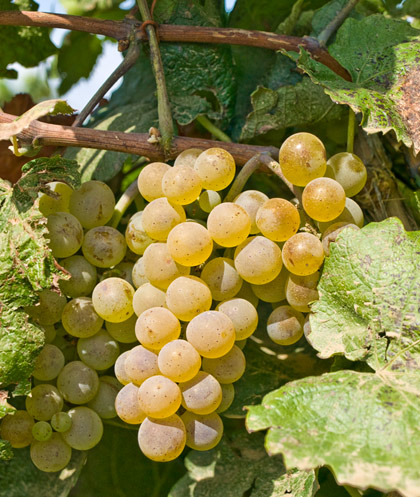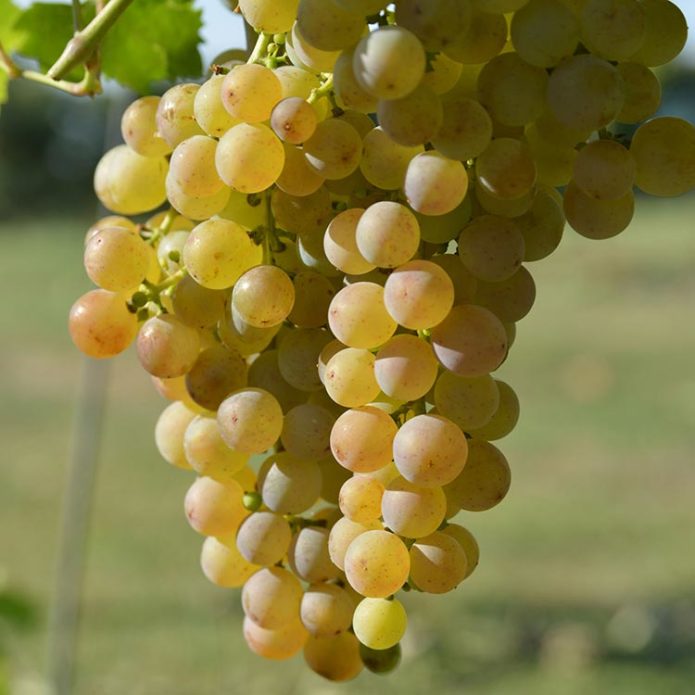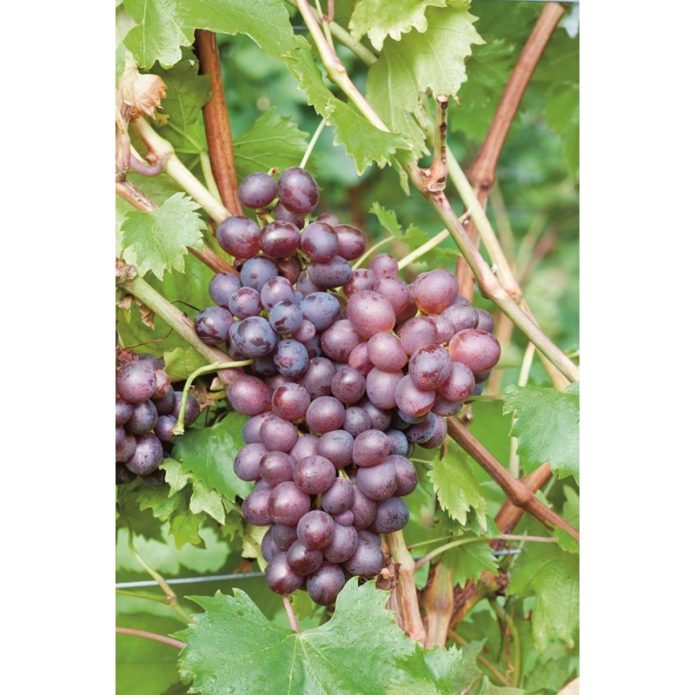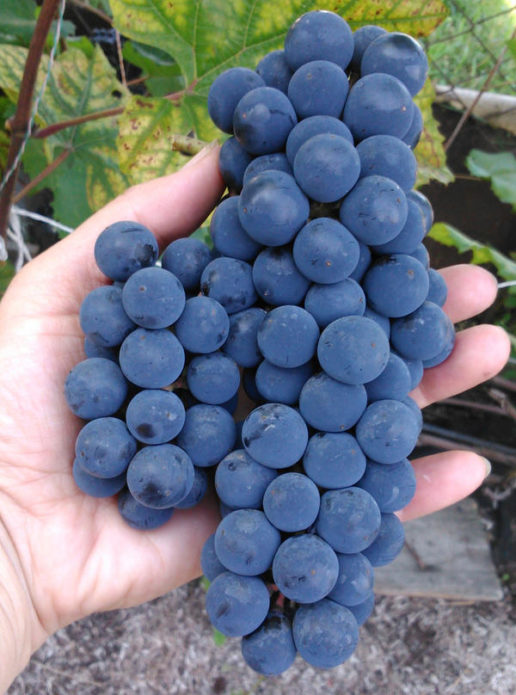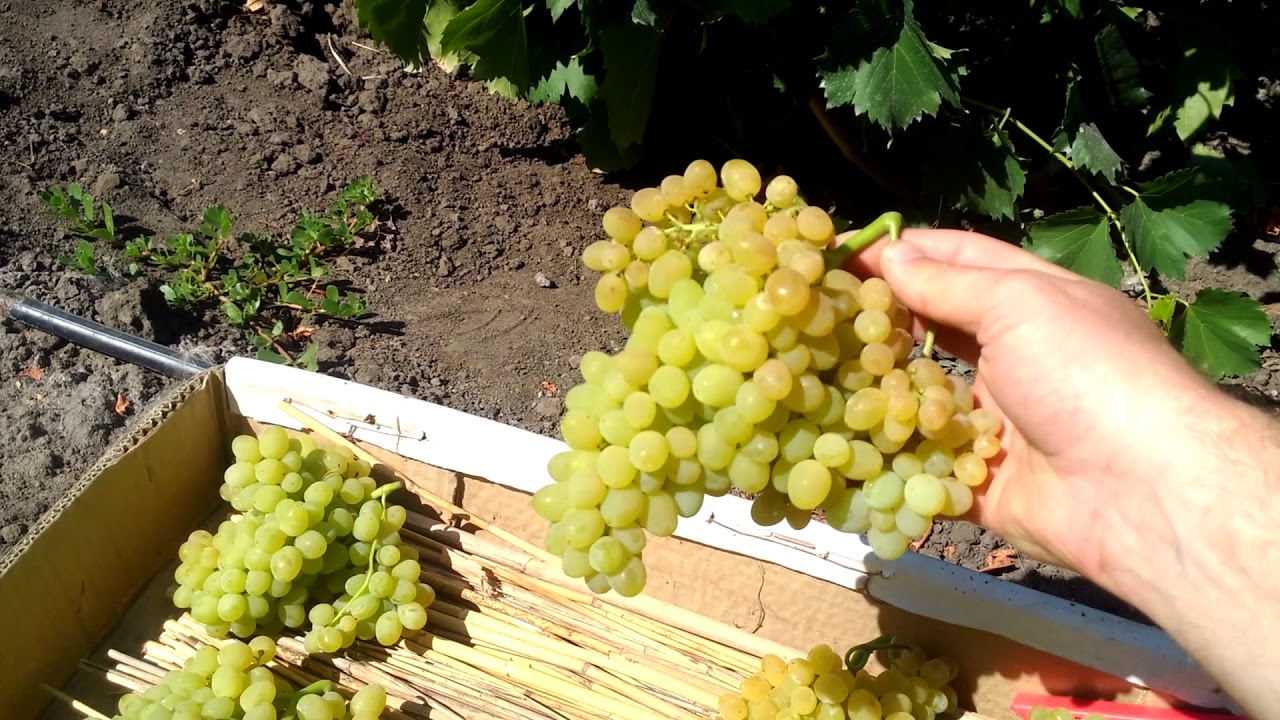All grape varieties are conventionally divided into table and technical. The berries of the first of them are mainly used fresh, the second are used for various processing, including in winemaking. This is due to the chemical composition of the fruit: the ratio of sugar and acid content, additional aromatic components, and, in general, the amount of juice in the berries. The best wine varieties are included in the technical list.
Content
Features and conditions for growing grape varieties for making wine
One would think that any grape variety is suitable for wine: it's not for nothing that this berry bears its name! However, this assumption is only partially true. Yes, indeed, wine can be made from any grape, however, from some varieties it turns out to be of poor quality.
Requirements for grape varieties for making wine
This is due to the fact that for normal alcoholic fermentation, the optimal sugar content in the must is about 25%, and not all technical grape varieties can boast of such a sugar content. But the acidity of most berries is too high so that, without dilution, a not too sour wine is obtained. In connection with the presence of such technological methods in winemaking, grape varieties of various sugar content and acidity are used.Thus, the sugar content in the pulp of berries ranges from 15.2% for Aligote grapes from Moldova to 30% for Furmint and almost 40% for overripe White Muscat. The acidity of wine varieties varies from 5.5 g / l (Cabernet) to 12 g / l for the same Aligote. The acids that make up grape juice are tartaric, malic, citric, etc. The ratio of sugar to acid affects the quality of any type of wine.
The color of the berries of technical grapes is a secondary matter, it determines the color of the wine and its belonging to the white, pink or red species, but it has only an indirect influence on the taste. Berries of various colors are used in winemaking, it is important that they contain a lot of juice (up to 85% of the berry mass).
Affects the chemical composition juice is also influenced by the climate of the area in which the grapes grow: the sum of positive temperatures during the growing season, relative humidity, soil composition, etc.
Technical varieties are grown in all geographic vineyards. Each region has its own varieties from which popular vintage wines are made, but many varieties are planted almost all over the world.
By the time of harvest, Livadia black grapes accumulate almost 25% of sugar, and acids - 7.8 grams per liter of juice, of which the berries contain 80–90%. Dry wine made from these berries was rated 7 by the tasters:https://flowers.bigbadmole.com/en/yagody/vinograd/vinograd-livadiyskiy-chernyiy.html
Video: about wine grapes for personal consumption
Features of growing wine grapes
In general, the cultivation of technical grapes is easier than that of table grapes. This is due to various reasons: both with their biological characteristics and with the requirements for the harvest. Most of the technical varieties are unpretentious: they are not capricious to weather conditions, they require slightly less nutrients, and they have higher resistance to diseases. They are usually more frost-resistant and do not require careful pruning. But in order to set the required sugar content, they must be illuminated by the sun no worse than table varieties, and in order for the berries to grow juicy, they must receive a sufficient amount of moisture.
Experts in industrial vineyards even tie up grapes in different ways: table varieties are grown on horizontal trellises, and technical ones - on vertical ones. In this regard, when planting wine varieties, they almost never dig out separate planting holes, since the vertical garter allows you to plant bushes in a compact manner, with distances from 0.5 to 1 meter from each other. In the industrial production of bushes, a lot is needed, so they immediately dig a deep planting trench to the entire required length. A distance of about one and a half meters is left between the rows.
In order to pre-apply a large amount of fertilizer, a trench is dug up to a meter deep. Otherwise, the planting does not differ from the generally accepted one: a layer of drainage from expanded clay, crushed stone or broken brick is laid on the bottom of the trench, then a layer of well-fertilized soil and above is a layer of clean fertile soil. Most often grapes are planted in spring, leaving 1-2 buds on the surface.
In the early years, the grapes are watered often and abundantly, then watering is needed only during the period of berry filling and in case of extremely dry weather. They try to carry out top dressing using organic fertilizers, burying them in small holes in early spring. Form the bushes of wine grapes in a fan, leaving only 2-4 sleeves. To obtain high-quality berries, it is necessary to normalize the yield in the case of tying a large number of bunches: no more than 2 kg should be collected from one bush.
Since most industrial varieties have increased frost resistance (up to -28 aboutC, or even lower), in the southern regions they are not even removed from supports for the winter. In the middle lane, winter shelter is required, but light. Experts advise covering the vine with light materials, but leave the tips of the shoots uncovered.
Grapes are one of the most common crops on the planet. In southern countries, the plant has been grown since antiquity, but it can grow and bear fruit even in northern latitudes:https://flowers.bigbadmole.com/en/yagody/vinograd/kak-posadit-vinograd.html
Video: rules for growing technical grape varieties
Popular wine grape varieties
There are more than one hundred technical grape varieties, and it is not possible to describe everything. Among them, however, there are the most popular, grown, if possible, in most regions. They are conventionally divided into white and colored varieties. Although, of course, the term "white" is conventional: such grapes can have shades from yellowish to green or, conversely, amber-yellow. The “colored” varieties have berries of various colors, but the “dark” varieties are distinguished separately, which are used to make red wines. These grapes can be dark red, blue, purple or nearly black.
Dark grape varieties for making red wine
- Isabella grape - perhaps the most common dark technical grade. Practically throughout the entire territory of our country, it is unconcealed. Sometimes it is planted simply to decorate plots, without the purpose of picking berries. A variety of American origin, grown in Europe for over 300 years. Caring for it is elementary: cut out all unnecessary, and the grapes will only grow better. The bushes are of medium vigor, the clusters are small, the packing of the berries is very dense. Berries weighing 2–3 g, purple or dark blue, with a waxy coating. They are colored already in August, but full ripening occurs closer to autumn frosts. The berries have a specific strawberry flavor. In European countries, wine from Isabella is banned: as if too much methyl alcohol and hydrocyanic acid were found in it. A controversial issue, but in Russia many amateurs grow Isabella for home winemaking.
- Lydia is a grape sometimes called Isabella rosea. Her frost resistance is lower than that of Isabella. Sometimes its berries are also used for table purposes, but their taste is not for everybody: the thick skin interferes with use, and the bones are poorly separated from the mucous pulp. The taste and aroma are even more reminiscent of strawberries, the acidity of the juice strongly depends on the degree of ripening. Lydia's popularity in Russia peaked in the middle of the twentieth century, but is now rapidly declining. The variety easily tolerates waterlogging. The berries are dark pink, but they ripen unevenly: from the central areas, those in the shade may not have time to fully ripen at all. Bunches rarely exceed a mass of 100 g, but the bush draws out a large number of them, so the overall yield is solid.
- Cabernet Sauvignon is one of the popular varieties from which many different red wines are produced. The berries are small, blue in color, almost black at full maturity, with a tart currant taste, giving off a nightshade, and a thick skin. The sugar content of the juice in the best seasons reaches 23%. The bunch weighs no more than 90 g, contains a lot of "peas", that is, very small berries, most of which fall off during the ripening process. The variety is disease- and frost-resistant, the growing season is 5–5.5 months. Despite the frost resistance, due to the late maturity, the distribution area is limited to the southern regions: in the conditions of the North Caucasus, it ripens no earlier than mid-October.
- Dove is a grape with almost black berries that gives an intensely colored juice.The taste contains tones of black currant, but very simple. Berries weighing about 2 g are collected in clusters of not very small size (up to 120 g). Ripens much earlier than Isabella: harvest is possible at the end of summer. Resistant to most pests and diseases, including phylloxera, frost resistance up to -24 aboutFROM.
- Black pearls are a medium-early ripening variety, the harvest is ready in early September. Bunches weighing up to 300 g, relatively dense. The berries are oval, dark blue in color, the flesh is juicy, with a nutmeg taste. From a bush, you can get up to 7 kg of berries with a high sugar content (up to 24%) and moderate acidity (6-7 g / l). Frost resistance up to -26 aboutC, in the southern half of Russia and Ukraine does not require shelter for the winter. With the use of standard preventive treatments, it practically does not get sick.
White grape varieties for wine making
- Chardonnay is a grape of French origin, grown in warm countries around the world, including in the southern regions of our country. Various types of wines are made from it: depending on the growing conditions, the juice can have apple, lemon, peach or any other flavor and aroma. Berries are greenish-white in color with a thin skin. It takes about 140 days from bud swelling to harvest; in the south of our country, the harvest ripens by the end of September. The variety is quite capricious: it does not feel well in conditions of high humidity, it often suffers from fungal diseases.
- Druzhba is an excellent technical white grape variety of domestic selection, bred in Novocherkassk. Unfortunately, its frost resistance is low, at the level of most table varieties (withstands temperatures of -23 aboutC), therefore, even in his homeland, he is often sheltered for the winter, just in case, and in the middle lane, shelter is required. But he has increased resistance to disease. Druzhba differs from most wine varieties in large berries and rather large clusters (weighing up to 300 g), the taste of nutmeg berries.
- Aligote - grapes without nutmeg aftertaste, with a slight aroma inherent in most common varieties. It belongs to the mid-early season, harvesting occurs at the end of summer. The bunches are of the usual size for wine varieties, the berries are yellow-green with golden-rusty spots on the sunny side and an abundance of brown dots. Sugar accumulation is fairly good, typically at least 18%. Frost resistance and susceptibility to major diseases at an average level. The variety is unstable against mildew, inflorescences are especially strongly affected. It responds positively to watering, but in unfavorable weather during ripening, the grapes strongly rot.
- White Muscat is famous all over the world. Strictly speaking, it cannot be called a technical grape, but excellent wines are made from it. This grape is widely used both fresh and for various types of processing. It takes about 140 days for the berries to ripen. The berries are very juicy, collected in clusters of medium size, weighing up to half a kilogram. The juice contains a large amount of sugar and has a unique aroma. The variety is not without its drawbacks: frost resistance and disease resistance are low, the bunches contain a large amount of "peas".
- Aksai - grapes of good taste, bred in VNIIViV them. Ya. I. Potapenko, ripens by mid-September. Bunches weighing up to 150 g, friable, white berries, round, weighing about 1.8 g. The pulp is juicy, the sugar content is up to 22%, but the overall acidity is quite high: more than 9 g / l. Up to 5 kg of berries are harvested from the bush. Disease resistance at an average level, withstands frosts down to -29 ° C. The chemical composition of the juice allows making excellent dry wines from it.
Selections of technical grape varieties for different regions
The most unpretentious technical varieties are grown in any climatic conditions, but it must be admitted that the best wine-growing regions, of course, are located in warm regions. In the middle lane, and even more so in the north, the range of good varieties for making wines is very limited.
Wine grapes of Ukraine
In most of Ukraine, the climate is suitable for growing almost any technical grape varieties. In addition to the above, the following are highly popular, for example:
- Bastardo Magarachsky is a variety that bears fruit with round dark blue berries and is used for making dessert wines. Received at VNII "Magarach". As a table variety, it is suitable to a limited extent, although it is tasty, but the berries are covered with a thick skin. Differs in increased sugar content: up to 30%. Bunches of medium size and density. In the central regions of Ukraine, the harvest takes place at the end of September. Disease resistance is average.
- Pink Muscat in all respects is very similar to White Muscat, but it is a dark grape: the name does not even fully correspond to the truth, the color of ripe berries is almost black. Bunches of medium size, weighing from 100 to 200 g. Berries with a strong nutmeg aroma, with a sugar content of 18 to 24%. It feels best in the southernmost regions, where it ripens in 140 days. Average yield, winter hardiness and disease resistance at a low level.
- Bianca (Bianco) - white grapes from Hungary, high-quality berries for the preparation of all types of wines contain up to 28% sugar. The variety is early, the harvest is ready to be harvested at the end of summer, it has a high yield and good frost resistance (up to -27 aboutFROM). Berries, depending on the place of cultivation, can have notes from floral to honey with a creamy tint in the taste, therefore the purpose of the variety is universal, it is used not only in winemaking. Disease resistance is above average.
- Riesling is one of the best light technical varieties. The bunch is small, loose. The berries are medium-sized, round, greenish-white with a tan on the sunny side. The skin is thin, almost transparent, but very firm, with small brownish dots. Sugar content ranges from 18 to 22% acidity - from 6.5 to 10 g / l. Medium ripening, good disease resistance. It also tolerates frosts normally, but feels better in the south of the country.
- Feteaska is a representative of early ripening technical varieties. The bunch is small, of moderate density. Fruits are round, small, greenish in color with rusty spots in the sun. The taste is pleasant, the juice content is high, the sugar content is up to 27%. The crop is ready for harvest at the very beginning of September, the yield is high. The variety is not resistant to diseases, and suffers greatly from pests. In all regions of Ukraine it winters without shelter.
Wine grapes of the Moscow region
Of course, the most popular grape varieties in the world cannot be grown in the central regions, since there is not enough heat and sun. The average July temperature in the Moscow region is 17 ... 19 ° C, the frost-free period lasts 4.5 months, frosts are possible until June 10 and after September 22. Therefore, most varieties of grapes, even for technical purposes, have to be grown with winter shelter. They try to plant the bushes on gentle southern slopes in shallow trenches along the south-north line. Be sure to ration the harvest, removing up to half of the bunches. Without normalization, the sugar content of the berries will be insufficient. Additionally, part of the leaves near them is removed, which contributes to better coloring of the berries.
Despite the difficulties, the popular in Russia Isabella and Lydia were planted by many summer residents at one time and are still not going to cut them down. In addition to them, the following varieties are in demand in the Moscow region:
- Crystal is a very early technical grade, its homeland is Hungary.The main purpose is growing in a warm climate, it is planted even in Georgia, but it is popular in the Moscow region, since it has enough time to ripen. However, shelter is necessary for the winter: its frost resistance is only -20 aboutC. A bunch of up to 200 g, white berries, very sweet. The variety requires very high illumination; otherwise, the berries not only do not ripen, but also crumble.
- Dobrynya is an example of dark grapes, origin - Novocherkassk. It can also be called technical only conditionally, since the bunches grow up to 800 g, the fruits are medium-sized, black, round, of good taste, juicy. Frost resistance is high, up to -35 aboutC, disease resistance is also good. Ripens in 110-120 days.
- Harmony is a mid-season variety, resistant to frost (up to -25 aboutC) and major diseases. Ripens 130–140 days after the first leaves appear. The clusters are medium in size, loosely packed with fruits. The berries are juicy, of harmonious taste, small, dark blue, but the juice is almost uncolored. Suitable for making any ruby-colored wines.
- Northern Saperavi is a mid-season variety, resistant to diseases, moderate frost resistance (up to -23 aboutFROM). The variety tolerates dry periods well and has a good yield. Average bunch weight 100 g. Berries are medium-sized, oval, harmonious taste, dark blue color with a strong waxy coating. The sugar content of the juice is from 20 to 25%. It is not used independently in winemaking, but it improves the taste of many other wines when blended. The average harvest time is 140 days from the beginning of the growing season, that is, approximately mid-September. It is characterized by a stable high yield.
- Amur - one of the easiest varieties to grow, bears fruit with small, ink-colored berries. One of the record holders for frost resistance, withstands -43 aboutC, therefore, for the winter it does not even require removal from the supports. The incidence is extremely rare. Although the berries outwardly somewhat resemble Isabella, they are completely different in taste: the taste of Amursky is simple, but sweet; packing of berries in bunches is loose. For maximum sugar content, must be grown in direct sunlight.
Kristall is one of the earliest technical grape varieties. It reaches technical ripeness within 110–120 days after the start of the growing season:https://flowers.bigbadmole.com/en/yagody/vinograd/vinograd-kristall-opisanie-sorta-foto-otzyivyi.html
Wine grape varieties for Siberia
In most of Siberia, growing grapes is difficult, but possible. A positive point is that he is very rarely sick here, and pests visit him a little. But hiding the kut for the winter is not an easy task. The peculiarities of the cultivation of grapes are manifested, for example, in the fact that in the summer they do not spray it, do not feed it and do not even loosen the soil, which educates the culture, preparing it to overcome difficulties. All green vine operations are carried out only in early summer. Such varieties as Isabella and Amursky feel quite good here. In addition, grapes are grown for the preparation of wines:
- Alpha is a variety very similar to Isabella. The average ripening period (up to five months), at the latitude of Biysk, the harvest is ready by mid-September. The taste of the berries is medium, but sometimes they are used fresh. The sugar content of the juice is 15–16%, the acidity is 10–11 g / l. The bunch usually weighs just under 100 g, exceptions are rare. The berries are almost black, with a purple hue and a strong waxy coating, weighing about 1.5 g. The taste reminds of Isabella due to the weak strawberry aroma. The variety is high-yielding, up to 2 kg of berries are harvested from the bush. Ultra-high frost resistance: up to -45 aboutC. Above average disease resistance.
- Muscat Katunskiy is a high-yielding medium late variety. The berries are ready by mid-September.The bunches can weigh up to a kilogram, the berries are white (weighing about 3 g), however, the variety is considered technical, used mainly for juicing and in winemaking. Average winter hardiness, shelter for the winter is mandatory, disease resistance is also at an average level. However, it tolerates rainy seasons well, keeping up even in the case of a cool summer.
- Early purple is a cultivar that answers the name. Brought to VNIIViV them. Ya.I. Potapenko. It takes no more than 120 days for the crop to ripen. Bunches weighing from 130 to 300 g, loose. Berries are dark purple in color, weighing about 2.5 g. The pulp is tasty, juicy. The aroma of nutmeg is strongly felt. The variety is high-yielding, it requires mandatory thinning of the bunches: without this operation, the quality of the crop drops sharply. The sugar content of the juice is 18–20%. Withstands frosts down to -30 aboutC, the incidence of diseases is low. It is used to prepare dessert wines with a delicate Muscat aroma.
Wine is rarely made from table grape varieties: their purpose is fresh use. Although many tasty berries are quite suitable for wine, technical varieties are mainly grown for these purposes, which are somewhat easier to cultivate. Homemade winemaking in our country is gradually declining, but true lovers of homemade products are in no hurry to part with a few bushes of grapes planted specifically for processing into wine.

